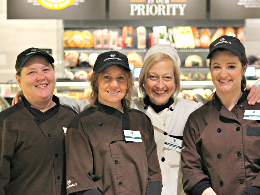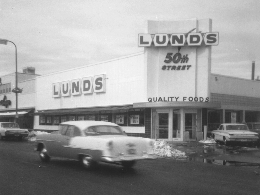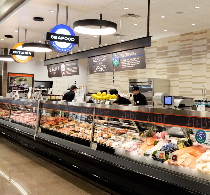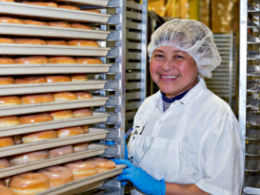Meet the Maker: Joe Ratuski from Canoe Wild Rice
August 6, 2025
Minnesota’s State Grain
Wild rice is the official state grain of Minnesota, but many don’t know that wild rice is technically not a rice at all. It’s actually a persistent annual aquatic grass that’s found growing in the cool waters of northern Minnesota. Native to Minnesota, wild rice has been used for food for at least 2,000 years in the Great Lakes region.
The plant was a primary food for the many native tribes in the Great Lakes region, including Algonquin, Ojibwe, Dakota, Winnebago, Sioux, Fox, and Chippewa. It was a valuable food source because it could be stored year-round once harvested and dried.
Wild rice is a food of great spiritual and cultural importance for Ojibwe people. According to their sacred story, their creator, Gichi-Manidoo, guided them on their journey to “the food that grows in water.” This gift from their Creator was nutritious in itself, but also housed many birds and waterfowl, which served as an additional food source. The Ojibwe named it “Manoomin,” meaning “good berry.”
Traditionally wild rice is harvested from lakes via canoes using only a pole for power and two rice knocker sticks. With a knocker in each hand, the ricer reaches to one side and pulls the stalks over the canoe. They gently knock or brush the stalks to remove the mature kernels into the canoe.
A Family Business
At Lunds & Byerlys, our team works with makers and growers throughout Minnesota – and the world – to bring you the best products possible. That’s why we partnered with Canoe Wild Rice, a fourth-generation family business, to create our own premium L&B Wild Rice.
Canoe Wild Rice is a trusted local business that began in the early 1900s after Peter Ratuski immigrated to Canada from the Ukraine. The family business began as a small grocery store in Red Lake, Ontario, which resulted in trading groceries for finished wild rice. All the wild rice was naturally lake-grown and found throughout Canada and Minnesota.
As the business grew, it was eventually passed on from Peter to his son, Ben, and a state-of-the-art plant was built on the riverbanks of the Winnipeg River outside Keewatin, Ontario in the early 1960s. This resulted in year-round wild rice production. From there, the market demanded a footprint in the United States, and a small-scale operation was purchased from a family friend in the early 1970s.
In the early 2000s, third-generation Chris Ratuski took over the family business and built a modern-day wild rice processing facility in Aitkin, Minnesota, that fresh-roasts newly harvested wild rice in a way that preserves all nutrients and flavor while reducing preparation and cooking time. This unique process remains unrivaled in the market. Chris’s sons – Joe and Sam – joined the family business in an official capacity in 2010 and the legacy and innovation continues.
Meet Joe Ratuski, General Manager
Joe Ratuski lives and breathes wild rice. His first job in the family business began at the age of 10, where he began as lead sweeper and groundskeeper. As the years went on, his role in the company grew and for nearly the last 10 years, he’s served as the general manager of the Aitkin mill. As Joe explains, “Our growers and I have all worked in the industry since childhood.” And it’s this lifelong dedication that makes all the difference.
People ask me all the time; do you ever get sick of wild rice? And, in all honestly, I don’t think I’ve ever passed up a wild rice meal,” says Joe. As the resident wild rice expert, we had to ask, what’s his go-to way to enjoy wild rice. “My all-time favorite wild rice dish is simple – fried bacon, onions and wild rice. It’s a hearty, delicious side dish.”
People ask me all the time; do you ever get sick of wild rice? And, in all honestly, I don’t think I’ve ever passed up a wild rice meal,” says Joe. As the resident wild rice expert, we had to ask, what’s his go-to way to enjoy wild rice. “My all-time favorite wild rice dish is simple – fried bacon, onions and wild rice. It’s a hearty, delicious side dish.”
From Farm to Plate
All wild rice comes from the same plant, whether it’s cultivated or naturally occurring in the wild. Natural wild rice is just that – it grows wild without any input or help from humans. Whereas cultivated wild rice – a process that began as early as the 1950s with much trial and error – relies on modern-day agricultural equipment to seed and flood the wild rice paddies and then drain and harvest. The family farms that started to cultivate wild rice are still innovating these processes to this day.
The care and consideration that the Ratuski family and the team at Canoe Wild Rice put into growing, harvesting and processing their wild rice is evident in every step of their process. Their mills are Safe Quality Food (SQF) Certified, Kosher certified and USDA Certified for their organic wild rice program.
Additionally, Canoe Wild Rice partners with the Aitkin County Developmental Achievement Center to provide differently abled individuals with fulfilling job opportunities. The Ratuski family and the team at Canoe Wild Rice care deeply about the community and the environment and providing local, sustainable wild rice for generations of Minnesotans – and beyond.
Sources: University of Minnesota and Canoe Wild Rice.










